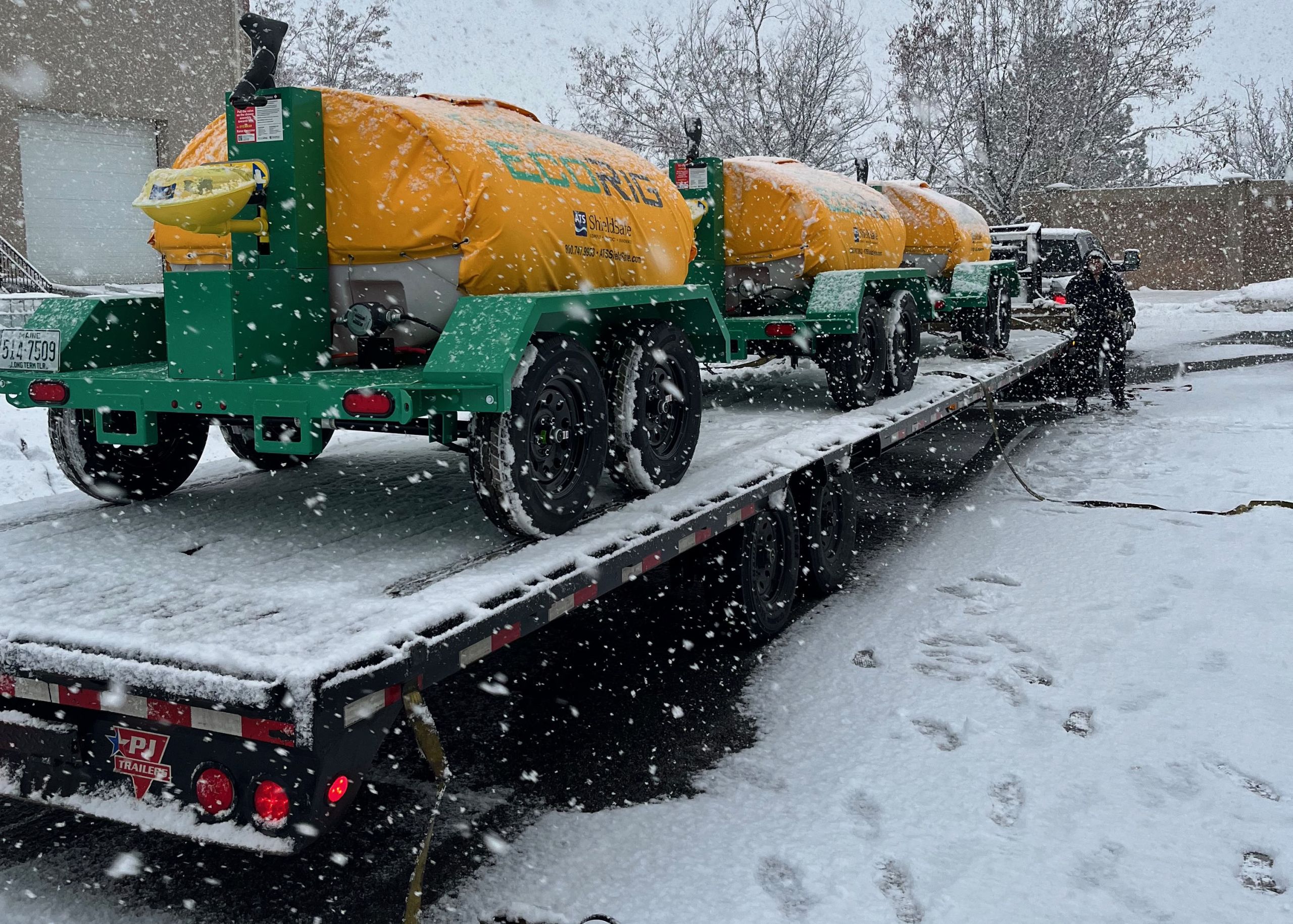In the dynamic and often hazardous world of oil and gas extraction and processing, safety is paramount. The unpredictability of weather, especially extreme conditions, adds a significant layer of complexity to maintaining a safe working environment. Enter the portable safety shower. The recent freeze in Texas during February 2021 serves as a stark reminder of the vulnerabilities our infrastructure faces in the face of such extreme weather events. This incident brought to light a critical issue: pipes burst, and many of the “permanent” safety showers and eyewashes, designed to be reliable safety measures, went offline due to freezing. This not only halted production at the facilities they were meant to protect but also exposed a significant gap in our preparedness for weather-related emergencies.
The freeze in Texas was not just a temporary inconvenience; it highlighted a systemic issue in how we approach the resilience of safety systems in extreme weather conditions. Facilities were left scrambling to find alternative solutions to maintain safety standards, as the infrastructure they relied on became incapacitated by the cold. The impact was multifaceted: not only were workers’ safety and health at risk due to the lack of functional decontamination facilities, but the halted production also led to significant financial losses and, in some cases, contributed to wider disruptions in the supply chain.
The Need for Systemic Change
This situation underscores the need for a reevaluation of our current safety infrastructure, with a focus on enhancing resilience to extreme weather conditions. It’s clear that reliance on permanent installations alone is not sufficient. These systems, often consisting of fixed safety showers and eyewashes, are vulnerable to the same environmental conditions that they are supposed to protect against. In the case of the Texas freeze, the water lines feeding these units froze, rendering them useless precisely when they might be most needed.

EcoRigs shipping out to handled a freeze event in January of 2024.
The lesson here is that redundancy and flexibility in safety systems are not just beneficial; they are essential. Portable safety showers and eyewashes emerge as a critical part of this redundancy. Unlike their permanent counterparts, portable units can be insulated against the cold, equipped with heaters, or even moved to locations less affected by the extreme weather. They can be quickly deployed to replace or supplement fixed systems that become inoperative due to weather conditions, ensuring that the facility can maintain operational safety standards.
Furthermore, this incident calls for a proactive approach to maintenance and preparedness. Regularly scheduled maintenance checks and winterization procedures for both permanent and portable safety systems can help prevent a repeat of the failures experienced during the Texas freeze. This includes insulating pipes, installing trace heating, and ensuring that all safety equipment has been tested and is functional regardless of the weather conditions.
Investing in weather-resistant safety solutions and adopting a more holistic approach to safety preparedness can help mitigate the risks associated with extreme weather events. By learning from the Texas freeze, the oil and gas industry can take steps to ensure that safety systems are as resilient and reliable as the workers they are designed to protect require them to be. This not only safeguards the health and safety of employees but also minimizes operational disruptions, contributing to the overall resilience of the industry in the face of increasingly unpredictable and extreme weather patterns.
Understanding the Challenge: Water Supply Vulnerabilities
The Texas Freeze: A Case in Point
During the Texas freeze, the challenges were not limited to the immediate effects of the cold on outdoor operations. One of the less obvious but equally critical impacts was on the water supply. It wasn’t just about pipes bursting on-site or the risk of outdoor equipment freezing. The city’s water supply itself became a significant concern. Municipal water systems were overwhelmed, leading to drops in water pressure or complete outages in some areas. This scenario posed a serious risk to facilities that relied on a consistent and controllable water supply for safety equipment, including emergency safety showers.
The Role of Portable Safety Showers
Portable safety showers offer a solution to this vulnerability by providing an independent and reliable water source that is not contingent on the stability of municipal systems. These units are designed to operate under a variety of conditions, ensuring that workers have access to decontamination facilities, even when external water supplies are compromised.
Key Features of Portable Safety Showers for Extreme Weather
Insulation and Heating
To combat the issues posed by freezing temperatures, portable safety showers for extreme weather are equipped with insulation and heating mechanisms. As long as the unit is energized these features ensure that the water remains at a safe temperature, preventing the water inside the shower from freezing and ensuring it’s ready for immediate use.
Self-Contained Water Supply
A self-contained water supply is a critical feature of portable safety showers designed for use in extreme weather conditions. This independence from municipal water systems means that even in the event of a water supply failure, as seen during the Texas freeze, the safety shower can still provide the necessary emergency decontamination.
Durability and Reliability
Our line of portable safety showers, the SafetyRig and the EcoRig are built for extreme weather conditions are designed with durability in mind. They can withstand the physical challenges posed by such environments, ensuring that they remain operational when needed most.
Integrating Portable Safety Showers into Emergency Preparedness Plans
Strategic Placement
Effective placement of portable safety showers is crucial. They need to be accessible within seconds in the event of an emergency, ensuring rapid treatment. This requires a thorough risk assessment of the site to determine the locations where spills or exposures are most likely to occur.
Regular Maintenance and Testing
Ensuring the functionality and reliability of portable safety showers, especially in extreme weather conditions, requires a consistent and comprehensive maintenance and testing regimen. Here are the critical components of this regimen:
Temperature Control
The water stored in the tank of a portable safety shower must be kept at a tepid temperature to ensure it’s safe and comfortable for use in treatment. Regular checks should be made using the temperature gauge located on the back of the unit. Tepid water is defined as having a temperature range between 60°F and 100°F (15.6°C to 37.8°C). Maintaining water within this temperature range is crucial to ensure that the victim can tolerate the full 15 minutes of treatment required for effective decontamination. This temperature range has been carefully selected to avoid causing thermal shock or hypothermia in the victim, which can occur if the water is too cold, or burns if the water is too hot. Ensuring the water is tepid enhances the likelihood that a victim will remain under the shower for the necessary duration, thereby maximizing the effectiveness of the decontamination process.
Air Pressure
For portable safety showers that operate with pneumatic pumps, ensuring that the air pressure is sufficient for delivering an adequate flow of water is crucial. Insufficient pressure can result in a weak flow, rendering the shower ineffective for proper decontamination. Regular checks and adjustments of the air pressure are necessary to maintain the operational readiness of the unit.
In systems powered by a gas cylinder, it is essential to ensure that the cylinder is full to provide the necessary pressure for the system to function correctly. A depleted gas cylinder will not be able to maintain the required air pressure, leading to reduced water flow and potentially compromising the effectiveness of the safety shower in emergency situations.
Regular monitoring and maintenance of the air pressure and gas cylinder are vital components of the safety shower’s upkeep, ensuring that in the event of an emergency, the unit can deliver a strong and steady flow of water for decontamination purposes.
Water Quality
The quality of the water in the tank is paramount. Over time, stagnant water can become a breeding ground for algae, bacteria, and other harmful microorganisms. To prevent this, the water quality should be regularly monitored. Utilizing a water treatment system like Waterguard offers a hands-off approach to stabilizing the tank water, ensuring it remains clean and safe for use.
Regular Activation Tests
Performing regular activation tests is critical to ensure that the shower is ready to use at a moment’s notice. These tests should cover the activation mechanism, flow rate, and overall operation of the unit. The manufacturer’s quickstart guide often provides a recommended procedure for these tests, ensuring that every aspect of the shower’s functionality is checked thoroughly.
By adhering to these maintenance and testing guidelines, companies can ensure that their portable safety showers remain in optimal condition, ready to provide immediate and effective decontamination in the event of an emergency. This proactive approach to maintenance not only helps in complying with safety regulations but also underscores a commitment to the health and safety of all personnel on site.
Training and Awareness
Training is an essential component of emergency preparedness. Workers must be familiar with the location and operation of portable safety showers. Regular drills can help reinforce this knowledge and ensure that in an emergency, the response is swift and effective.
Conclusion
The recent freeze in Texas highlighted the critical need for resilience in safety protocols, particularly concerning water supply vulnerabilities. Portable safety showers emerge as a vital component of this resilience, offering an independent, reliable, and weather-proof means of ensuring worker safety. As the oil and gas industry continues to navigate the challenges posed by extreme weather, the importance of these portable units and the role they play in emergency preparedness cannot be overstated. Ensuring the safety of workers in extreme conditions is not just a regulatory requirement but a moral imperative, and portable safety showers are at the forefront of meeting this challenge.

